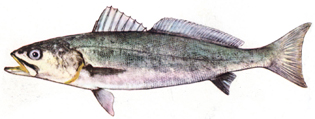
Geelbek / Cape Salmon
Geelbek can be distinguished from other species in the Sciaenidae family by their concave tails. Adults are found in areas with sandy bottoms, rocky reefs and near wrecks or pinnacles at depths between 15 and 150m. They feed mainly on other fish species including pilchards, maasbanker and mackerel.
Adults migrate from the Western and Eastern Cape towards Kwa-Zulu Natal, where they spawn during spring.
Geelbek is an important commercial and recreational species, but the stock collapsed in recent years due to overexploitation by the line-fishery in particular. Stricter linefishery regulations have been put in place and there are indications that this species might be showing signs of recovery.
The minimum size limit is 60cm for recreational and commercial fishers.
SASSI status: Orange for linefishing, Red for inshore demersal trawl
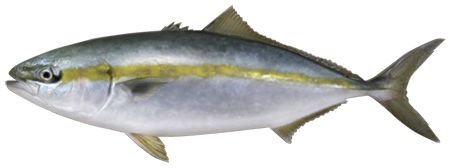
Yellowtail /Geelstert
Giant yellowtail live in the cold Atlantic waters off the Cape. During the annual sardine run, they migrate towards the east coast of southern Africa to feast on the sardines.
Yellowtail gather in large shoals offshore, at depths of up to 110m. They are fast torpedo-shaped predatory fish that feed on smaller fish and squid.
Yellowtail is an important commercial line-fish species in the Western Cape. There is no minimum legal size at which yellowtail may be caught, but since most females only reach sexual maturity at 1.2m (between two and three years of age) and most males at 900cm, it is vitally important that anglers and fisheries ensure that smaller yellowtail are not removed from the ocean as they still need time to mature and reproduce.
Yellowtail is currently listed as a green species by SASSI. Green-listed species are a good choice because they are more plentiful and they can cope better with fishing pressure.
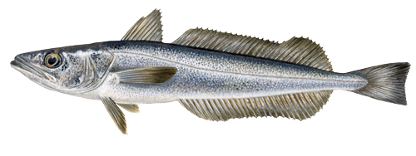
Hake / Stokvis
Hake are deep-sea members of the Cod family, found on the continental shelf and slope to depths over 1,000 metres.
They are a mild fish, having a more subtle flavour than cod. Hake is considered one of the best fish in the whiting family because of its firm, sweet, white meat and medium flake.
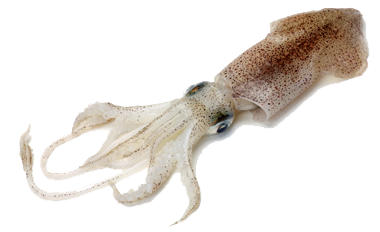
Calamari / Squid
What is the difference between squid and calamari?
Squid and calamari are two different beasts. Squid is cheaper and tougher; calamari is more tender and expensive. Squid is generally Nototodarus gouldi, also known as Gould's squid, but a species named Teuthoidea is also targeted. Calamari come from the genus Sepioteuthis. You can see the word "sepia" in the name, which refers to their ink. You can tell squid from calamari by the fins that form an arrow shape on the end of the squid's hood. The fins of calamari extend almost all the way down the hood. My fishmonger insists you can make squid as tender as calamari by marinating it with kiwi fruit. Try buying smaller squid, chopping up their fins and tentacles and stuffing these back into the hood with breadcrumbs and slowly cooking in a tomato and garlic sauce. The slow cooking tenderises the squid's flesh.

Rock Lobster / Kreef
South African seafood lovers and fishermen often erroneously speak of crayfish, when in fact they mean lobster. Many restaurants also incorrectly list crayfish instead of lobster on their menus.
The major difference is that crayfish (also called crawfish) are mostly found off the US coast, and live in fresh water, whereas rock lobsters (also called spiny lobsters) live in the Atlantic Ocean, and are found predominantly off the coasts of southern Africa and Australia.
Whereas crayfish are prized for their meaty claws (and tail), it’s the sickle of almost-sweet, soft, delicate white meat in the rock lobster’s tail that gets seafood lovers salivating.
Of South Africa’s rock lobster species, West Coast and South Coast rock lobsters can be sustainably consumed and are therefore commercially harvested. Natal deep-sea rock lobster, though legal, is vulnerable to depletion. East Coast rock lobster is a red list species and may only be hand collected.
Anyone wishing to dive for lobsters in South Africa requires a permit available at any South African Post Office. The lobster season (usually mid November to end April), is strictly controlled with seasonal and daily bag limits applying. Recreational anglers may catch 4 lobsters per person per day, and the size restriction is 80mm carapace length.

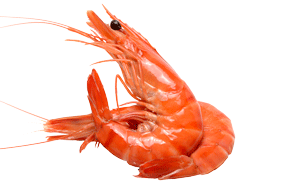
Prawn / Shrimp
Prawn is a common name, used particularly in the United Kingdom, Ireland, and Commonwealth nations, for large swimming crustaceans or shrimp, especially those with commercial significance in the seafood industry. Shrimp that fall in this category often belong to the suborder Dendrobranchiata. In North America, the term is used less frequently, typically for freshwater shrimp.
In the United Kingdom, prawn is more common on menus than shrimp, while the opposite is the case in the United States. The term prawn also loosely describes any large shrimp, especially those at 15 (or fewer) to the pound (such as king prawns or jumbo shrimp).
Whiteleg shrimp (Litopenaeus vannamei, formerly Penaeus vannamei), also known as Pacific white shrimp, is a variety of prawn of the eastern Pacific Ocean commonly caught or farmed for food.
35 Harbour Road, Kleinmond 7195 - Po Box 577, Kleinmond, 7195 - KabelJoe's Seafood Restaurant Pty Ltd. 2014/168255/07
028 271 3336